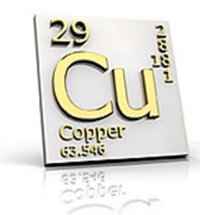The Copper Ion That Wasn't an Accident
Charged metal particle lets industrial catalyst add and remove electrons
(May 2012)

Proven reduction/oxidation of its copper atoms makes Cu-BTC the newest member of a small family of redox-capable metal organic frameworks and greatly expands its range of potential applications.
Results: Thought to be an impurity in the industrial catalyst Cu-BTC, the copper ion Cu+ is actually part of the material and could expand the catalyst's repertoire, according to scientists at Pacific Northwest National Laboratory and University of Caen. By controlling the catalyst's surroundings, the team made the metal organic framework more reactive. The improved reactivity is seen in the material's ability to handle changes in the number of electrons on its copper atoms, switching between Cu2+ and Cu+.
Why It Matters: In combating the need for fossil fuels, new technologies demand materials with new capabilities. This research shows that Cu-BTC has more tricks up its metaphorical sleeve than previously thought. The catalyst can oxidize and reduce materials; that is, add and remove electrons by changing between the two forms of copper ions. This is a rare trait in materials known as metal organic frameworks and could lead to new applications for the porous catalyst.
"This work opens the way to applications not considered up to now," said Dr. Janos Szanyi, a catalyst science at PNNL who worked on the study. "Examples include selective separation of gases, and partial oxidation of organic compounds."
 In combating the need for fossil fuels for transportation, residential and industrial use, new technologies demand materials with new capabilities.
In combating the need for fossil fuels for transportation, residential and industrial use, new technologies demand materials with new capabilities.
Methods: Both Cu2+ and Cu+ were known to exist in Cu-BTC, also known as HKUST01, although Cu+ was thought to be present only because of sample impurities. Using infrared spectroscopy tools at EMSL, researchers measured the ratio of Cu2+:Cu+ in Cu-BTC exposed to various conditions. The team showed that Cu+ can be present in high concentrations, independent of impurities. Reduction, or the generation of the largest number of Cu+ sites, was most successful via treating Cu-BTC under vacuum at 473 K. Re-oxidation or the loss of electrons to turn the Cu+ back to Cu2+ sites was most successful in a nitrogen dioxide atmosphere at the same temperature.
The structure of Cu-BTC was found to be very stable, not degrading after repeated reduction and oxidation cycles.
The team has also shown that the presence of open Cu2+ and Cu+ cation sites created centers for the formation of nitrites and methoxides. This property, characteristic of oxides, was observed the first time in this study.
What's Next? The team's approach can be expanded to analyze similar materials, and their new knowledge about Cu-BTC will open doors to refine existing applications as well as create new applications for these novel materials.
Acknowledgments:
Sponsor: U.S. Department of Energy, Office of Basic Energy Sciences, Chemical Sciences, Geosciences and Biosciences Division.
User Facility: EMSL
Research Team: Janos Szanyi, Marco Daturi, Donald R. Baer and Charles H. F. Peden, PNNL; Guillaume Clet, University of Caen, France
Reference: J Szanyi, M Daturi, G Clet, DR Baer, and CHF Peden. 2012. "Well-Studied Cu-BTC Still Serves Surprises: Evidence for Facile Cu2+/Cu+ Interchange." Physical Chemistry Chemical Physics 14(13):4383-4390. DOI:10.1039/c2cp23708c.
